Food Safety
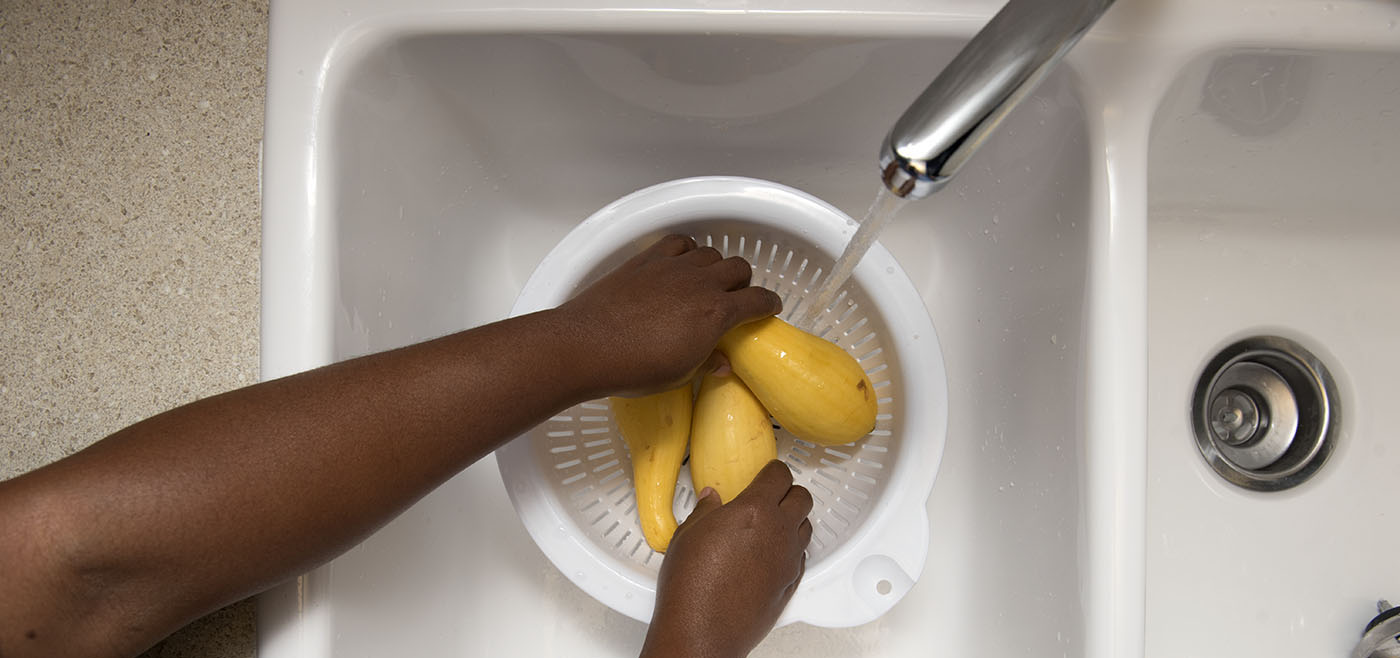
Clean / Separate / Cook / Chill
CLEAN: Wash Hands and Surfaces Often
Bacteria can be spread throughout the kitchen and get onto hands, cutting boards, utensils, counter tops, and food.
- Wash your hands with warm water and soap for at least 20 seconds before and after handling food and after using the bathroom or changing diapers. Wash your hands after playing with pets or visiting petting zoos.
- Rub your hands together to make a lather and scrub them well. Be sure to scrub the backs of your hands, between your fingers, and under your nails.
- 20 seconds is about the time it takes to sing the “Happy Birthday” song twice.
- Dry your hands with a clean cloth or paper towel.
- Wash your countertops, cutting boards, dishes, and utensils with hot, soapy water after preparing each food item and before going on to the next food item.
- Consider using paper towels to clean up kitchen surfaces. If you use cloth towels, wash them often in the hot cycle of your washing machine.
- Keep your fridge clean, too: wipe spills immediately and regularly clean the inside with hot water and liquid soap. Dry with paper towels.
- Rub firm-skinned fruits and vegetables, including those with skins and rinds that are not eaten, under running tap water or scrub with a clean vegetable brush while rinsing with running tap water.
- Packaged fruits and veggies labeled “ready-to-eat,” “washed,” or “triple-washed” should not be washed. Doing so may increase the risk for cross-contamination.
- Do not use soap or bleach to wash produce. These products are not intended for consumption.
- Keep books, backpacks, or shopping bags off the kitchen table or counters where food is prepared or served.
SEPARATE: Don’t Cross Contaminate
Cross contamination is how bacteria can be spread. When handling raw meat, poultry, seafood, and eggs, keep these foods and their juices away from ready-to-eat foods. Always start with a clean scene—wash hands with warm water and soap. Wash cutting boards, dishes, countertops, and utensils with hot, soapy water.
- Separate raw meat, poultry, seafood, and eggs from other foods.
- In the grocery store: place these products in separate plastic bags to prevent juices from getting on other foods. If you use reusable grocery bags, wash them frequently in the washing machine.
- At home: place these products in sealed plastic bags or containers on the bottom shelf of the refrigerator to prevent juices from contaminating other foods. If you don’t plan to use these foods within a few days, freeze them.
- Keep fresh fruits and vegetables separate from raw meat, poultry, seafood, and eggs.
- Use one cutting board for fresh produce and a separate one for raw meat, poultry, and seafood.
- Use a food thermometer, which measures the internal temperature of cooked meat, poultry, and egg dishes, to make sure that the food is cooked to a safe internal temperature.
- Never place cooked food on a plate that previously held raw meat, poultry, seafood, or eggs.
- Sauce that is used to marinate raw meat, poultry, or seafood should not be used on cooked food unless it is boiled first to destroy any harmful bacteria.
COOK: Cook to Proper Temperatures
Food is safely cooked when it reaches a high enough internal temperature to kill the harmful bacteria that cause foodborne illness. Use a food thermometer to measure the internal temperature of cooked foods.
- Color is Not a Reliable Indicator of Safety
- Color and texture are not reliable indicators of whether food has reached a high enough internal temperature to destroy pathogens.
- According to USDA research, 1 in 4 hamburgers turn brown before reaching a safe internal temperature.
- Use a food thermometer, which measures the internal temperature of cooked meat, poultry, and egg dishes, to make sure that the food is cooked to a safe internal temperature.
- Food thermometers should be placed in the thickest part of the food, making sure not to touch bone, fat, or gristle.
- Cook beef roasts and steaks to a safe minimum internal temperature of 145°F. Cook pork to a minimum of 145°F. All poultry should reach a safe minimum internal temperature of 165°F throughout the bird, as measured with a food thermometer.
- Cook all ground meat to 160°F. Information from the Centers for Disease Control and Prevention (CDC) links eating undercooked ground beef with a higher risk of illness. Remember, color is not a reliable indicator of doneness. Use a food thermometer to check the internal temperature of your burgers.
- Cook eggs until the yolk and white are firm, not runny. Don’t use recipes in which eggs remain raw or only partially cooked. Casseroles and other dishes containing eggs should be cooked to 160°F.
- Cook fish to 145°F or until the flesh is opaque and separates easily with a fork.
- Bring sauces, soups, and gravies to a boil when reheating. Heat other leftovers thoroughly to 165°F.
- For best microwave-safe cooking:
- Make sure there are no cold spots in food (where bacteria can survive) when cooking in a microwave oven. For best results, cover food, stir, and rotate for even cooking. If there is no turntable, rotate the dish by hand once or twice during cooking.
- Use microwave-safe cookware and plastic wrap when cooking foods in a microwave oven.
- Read and follow package cooking directions; most convenience foods are not ready to eat out of the container. Make sure you know if the directions require a microwave oven or a conventional oven.
- Know your microwave’s wattage; if it is lower than the wattage in cooking instructions, the food will take longer to heat up.
CHILL: Refrigerate Promptly
Refrigerate foods quickly because cold temperatures slow the growth of harmful bacteria. Do not over-stuff the refrigerator. Cold air must circulate to help keep food safe. Keeping a constant refrigerator temperature of 40°F or below is one of the most effective ways to reduce the risk of foodborne illness. Use an appliance thermometer to be sure the temperature is consistently 40°F or below. The freezer temperature should be 0°F or below.
- Don’t go too low: As temperatures approach 32°F, ice crystals can form and lower the quality of foods.
- Never let raw meat, poultry, eggs, cooked food, or cut fresh fruits or vegetables sit at room temperature more than two hours before putting them in the refrigerator or freezer (one hour when the temperature is above 90°F).
- Never defrost food at room temperature. Food must be kept at a safe temperature during thawing. There are three safe ways to defrost food: in the refrigerator, in cold water, and in the microwave using the defrost setting. Food thawed in cold water or in the microwave should be cooked immediately.
- Always marinate food in the refrigerator.
- Divide large amounts of leftovers into shallow containers for quicker cooling in the refrigerator.
- Use or discard refrigerated food on a regular basis.
- To prevent the spread of harmful bacteria, wipe spills immediately. Regularly clean the inside of your fridge with hot water and liquid soap, and dry with a clean cloth or paper towels.
Keeping Cold Lunches Cold
Prepare cooked food, such as turkey, ham, chicken, and vegetables or pasta salads, ahead of time to allow for thorough chilling in the refrigerator. Divide large amounts of food into shallow containers for fast chilling and easier use. Keep cooked food refrigerated until time to leave home.
To keep lunches cold away from home, include a small frozen gel pack or frozen juice box. Of course, if there’s a refrigerator available, store perishable items there upon arrival. Insulated, soft-sided boxes or bags are best for keeping food cold, but metal or plastic lunch boxes and paper bags can also be used. If using paper lunch bags, create layers by double bagging to help insulate food.
Some food is safe without a cold source. Items that don’t require refrigeration include whole fruits and vegetables, hard cheese, unopened canned meat and fish, chips, breads, crackers, peanut butter, jelly, mustard, and pickles.
Keeping Hot Lunches Hot
Use an insulated container to keep food like soup, chili, and stew hot. Fill the container with boiling water, let stand for a few minutes, empty, then put in the piping hot food. Keep the insulated container closed until lunchtime to keep the food hot—140°F or above.
For more information, visit the USDA Food Safety and Inspection Service (FSIS).
Refrigerating or Freezing Foods
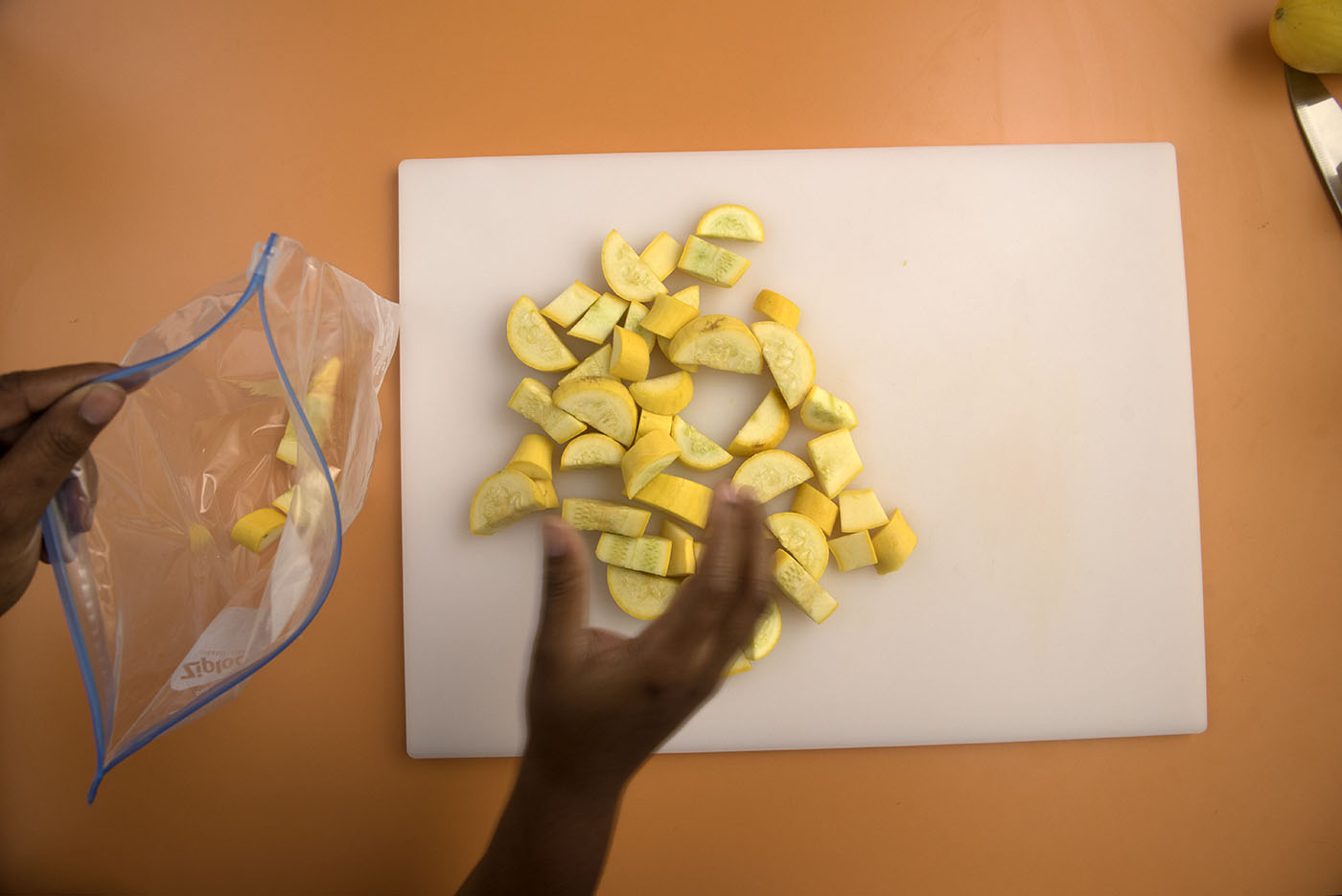
How long can you store foods?
These short but safe time limits for home-refrigerated foods will keep them from spoiling or becoming dangerous to eat. The guidelines for freezer storage are for quality only. Frozen foods remain safe indefinitely.
|
Category |
Food |
Refrigerator (40F or below) |
Freezer (0F or below) |
|
Salads |
Egg, chicken, ham, tuna, and macaroni salads |
3 to 5 days |
Does not freeze well |
|
Hot dogs |
Opened package |
1 week |
1 to 2 months |
|
Unopened package |
2 weeks |
1 to 2 months |
|
|
Luncheon Meat |
Opened package or deli sliced |
3 to 5 days |
1 to 2 months |
|
Unopened package |
2 weeks |
1 to 2 months |
|
|
Bacon and sausage |
Bacon |
7 days |
1 months |
|
Sausage, raw—from chicken, turkey, pork, beef |
1 to 2 days |
1 to 2 months |
|
|
Hamburger and other ground meats |
Hamburger, ground beef, turkey, veal, pork, lamb, and mixtures of them |
1 to 2 days |
3 to 4 months |
|
Fresh beef, veal, lamb, and pork |
Steaks |
3 to 5 days |
6 to 12 months |
|
Chops |
3 to 5 days |
4 to 6 months |
|
|
Roasts |
3 to 5 days |
4 to 12 months |
|
|
Fresh poultry |
Chicken or turkey, whole |
1 to 2 days |
1 year |
|
Chicken or turkey, pieces |
1 to 2 days |
9 months |
|
|
Soups and stews |
Vegetable or meat added |
3 to 4 days |
2 to 3 months |
|
Leftovers |
Cooked meat or poultry |
3 to 4 days |
2 to 6 months |
|
Chicken nuggets or patties |
3 to 4 days |
1 to 3 months |
|
|
Pizza |
3 to 4 days |
1 to 2 months |
Partnership for Food Safety Education 2016
Storing Food at Room Temperature
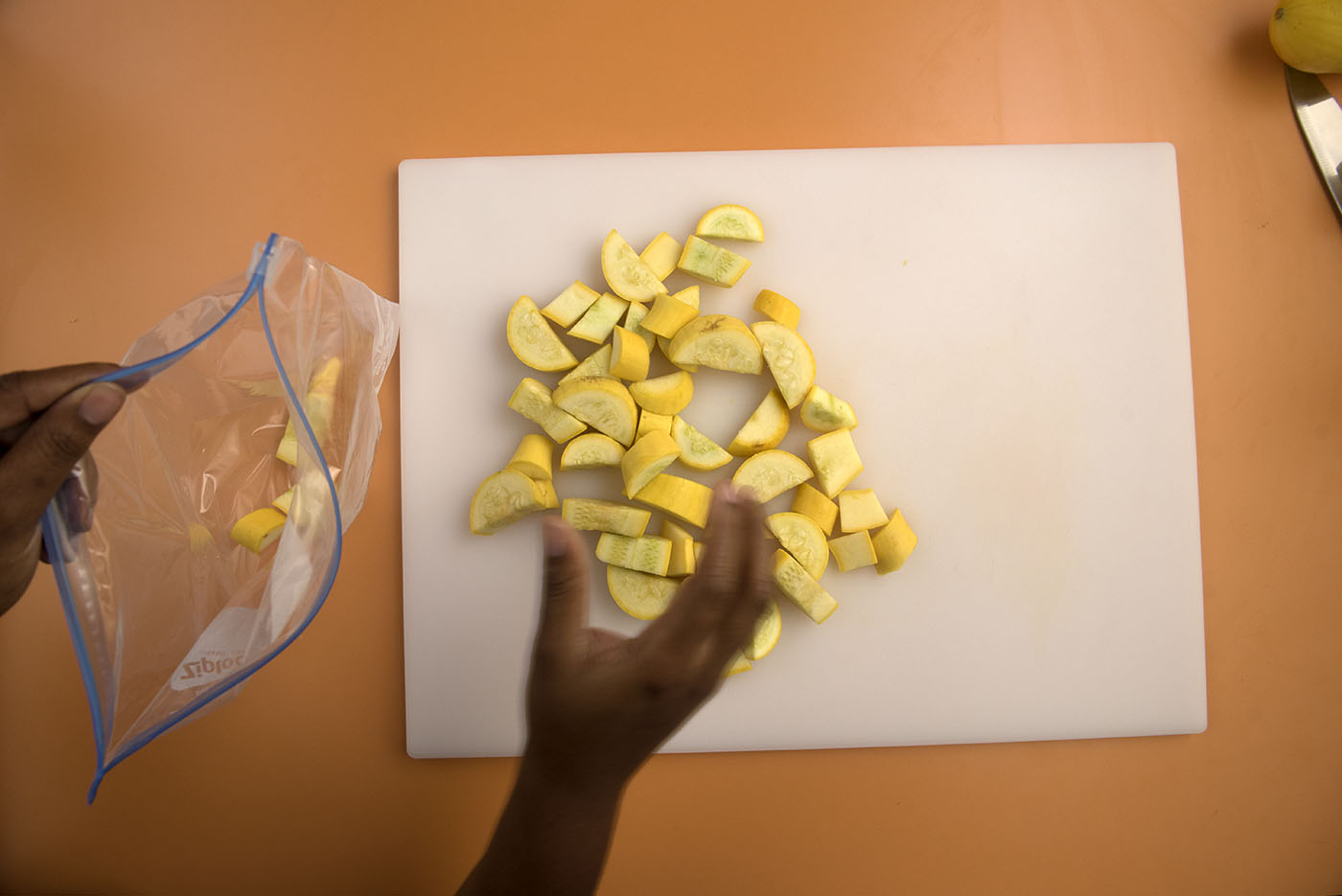
Storing Food at Room Temperature
- Cooked foods should not remain at room temperature for more than two hours. The sooner you can get it in the refrigerator or freezer, the better.
- Some foods, such as apples, can be left at room temperature and can be stored for 3–4 days.
- Food should not be left out in a pan/casserole dish on the stove to cool. It needs to be in the refrigerator as soon as possible.
- Some foods can be left at room temperature and stored on the counter-top or in cupboards in covered containers.
- Bread can be left on the counter in its original packaging, but it will keep longer if kept in the refrigerator. Bread can also be stored in the freezer to keep it for use at a later time.
Cooling and Refrigerating Food
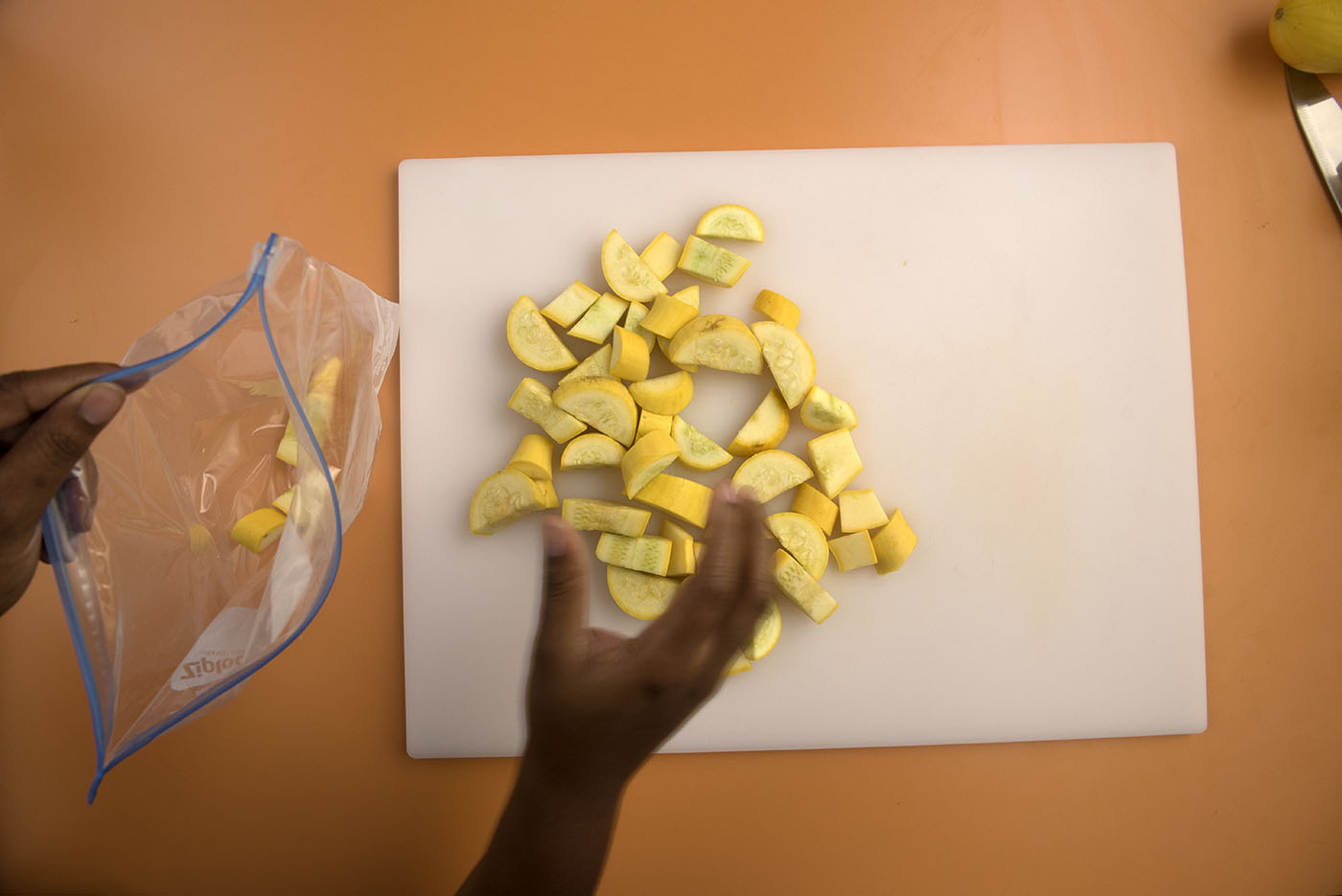
Cooling and Refrigerating Food
- Separate and refrigerate the portion to be served for your next meal BEFORE you put the food on the table. This keeps food quality higher by preventing leftovers from becoming “picked-overs.” It also helps keep food safe.
- Refrigerate leftovers in shallow containers so they cool faster in the refrigerator. It’s not necessary for a food to be completely cool before it’s refrigerated. To help food cool slightly before refrigeration, place a shallow container of food on a cooling rack to allow air to circulate all around the plan for about 20 to 30 minutes.
- Limit depth of food to 2 inches. LOOSELY cover food upon refrigeration. This allows heat to escape and protects from accidental contamination from other foods during cooling.
- Avoid letting perishable cooked foods, such as meat, poultry, seafood, eggs, dairy products, cooked rice, pasta, and vegetables sit at room temperature longer than TWO hours TOTAL—the TOTAL is the total of the first and second use.
- Refrigeration does not stop bacteria from growing, but it slows the process. Most food will only keep in the refrigerator for a short period of time.
- Food should always be covered or in a storage container with a sealed lid to slow the growth of bacteria.
- Label and date your leftover containers to keep track of how long it has been in the refrigerator.
- If food looks or smells bad, the general rule is, “When in doubt, throw it out!”
- Do not overstuff the refrigerator. Cold air needs to be able to circulate to keep food safe and prevent freezing.
- A refrigerator temperature of 40°F or lower will slow bacterial growth. Keep your freezer at 0°F or lower. Freezing will stop most bacteria growth so frozen foods keep longer than those at refrigerator temperature. Freezing DOES NOT kill bacteria—it is still important to handle food safely.
As a general rule, use refrigerated leftovers within four days for best safety and quality. Freeze for longer storage. Cool foods in the refrigerator before putting them in your freezer.
Freezing Food
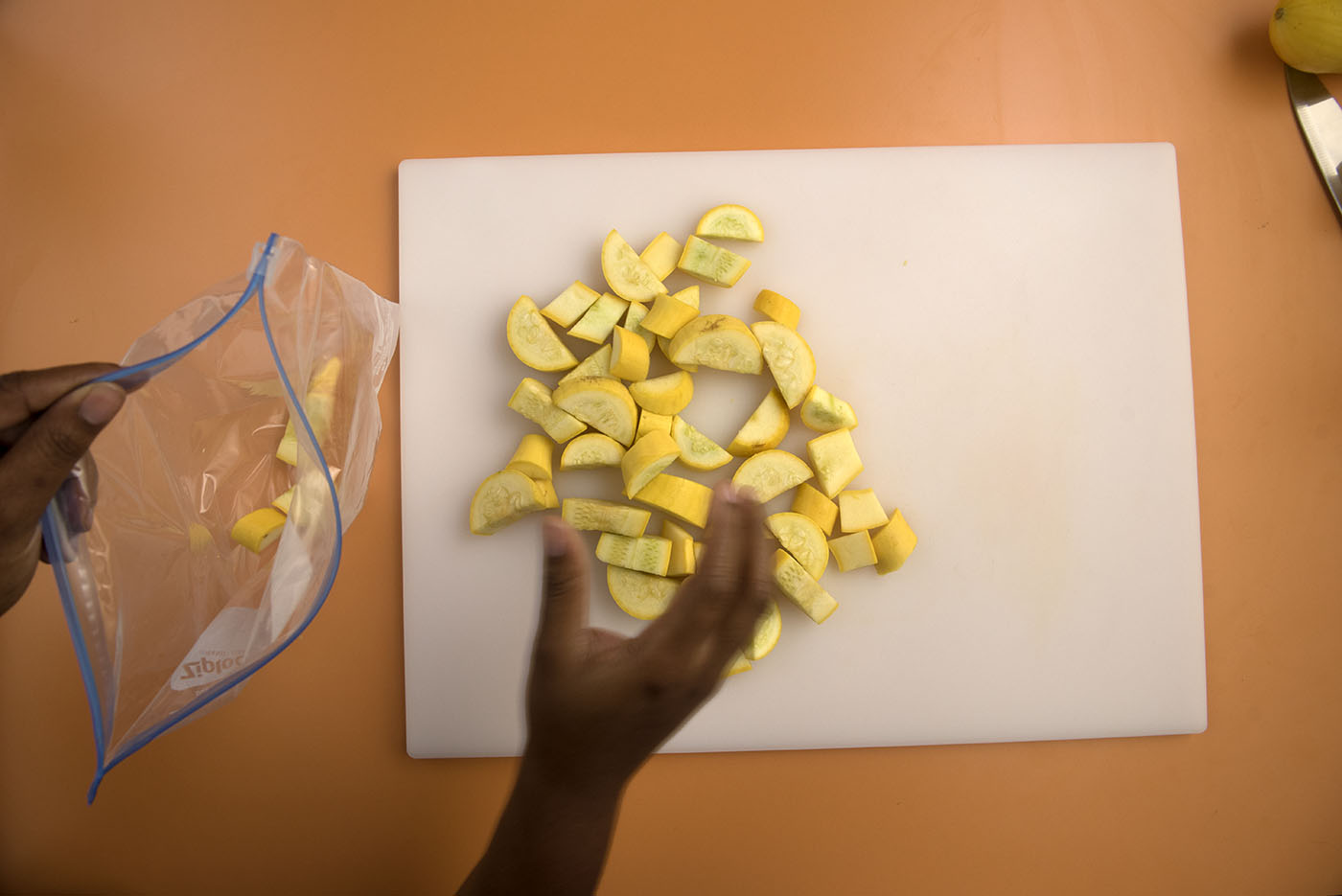
Freezing Food
- Your freezer should be kept at or below 0°F. This can be checked by keeping a thermometer in your freezer.
- If you are not planning to eat your leftovers within a few days or want to keep leftovers longer, store them in the freezer. This will stop bacteria from growing.
- Freeze foods in portion sizes you’ll need for future meals. For example, if there are two in your family and you each eat a cup of rice for a meal, freeze in two-cup portions.
- To hasten thawing when freezing foods: freeze in a thinner, flattened shape in freezer bags or freezer foil. A round shape takes longer to thaw through to the middle. Flatter packages also will stack better in your freezer.
- Remember to cool foods to refrigerator temperature before putting them in your freezer.
- Pack foods fairly tightly into containers or press out excess air when packing food in bags. For most foods, it’s helpful to leave a little space (about ½ inch) between the food and the freezer package closure to allow for expansion of the food as it freezes.
- While frozen food remains safe indefinitely at 0°F, the quality deteriorates the longer it’s stored.
- “Freezer burn,” when the surface of the food appears light-colored and dried out, occurs when moisture on the surface evaporates. Proper cooling, air removal, moisture-vapor-resistant packaging, a tight seal, and an appropriate length of storage help prevent freezer burn. While a food with freezer burn is safe to eat, the quality is lower.
- Prevent ice cream freezer burn by placing plastic wrap on the top before replacing the lid.
- Label each package with the type and amount of contents. Use the dates to assure products are eaten while the quality is still good.
- If you’re freezing several packages at once, leave a little space between them so air can circulate freely and they freeze faster. Move them closer together when they’re frozen.
Foods that DON’T freeze well
- Cooked eggs
- Cooked “chunks” of potatoes (mashed and twice-baked may freeze satisfactorily)
- Custards and cream puddings, by themselves or in pies
- Potato salad
- Pasta
- Raw, watery vegetables such as lettuce, cucumbers, and radishes; tomatoes, celery, and cabbage might be satisfactorily frozen as an ingredient in an already cooked dish such as a soup or casserole.
- Yogurt and sour cream
- Mayonnaise may separate during freezing and thawing
- Sauces and gravies thickened with flour or cornstarch may separate and bread down when frozen
- Fried foods may lose their crispiness
- Crumb toppings, such as on casseroles, may become soggy after freezing.
Sometimes you will see these foods in commercially frozen products because food companies have equipment that freezes food faster and helps retain quality better. Also, various ingredient, generally unavailable to home cooks, are used commercially to help prevent frozen foods from breaking down.
Before you double a recipe for frozen leftovers, experiment by freezing a small amount the next time you make the recipe. If you’re satisfied with the results, prepare extra food for freezing when you make the recipe again.
As a general rule, foods with high water content, such as the vegetables in our list, do not freeze well. The water in food expands during freezing and breaks down the food’s structure, making the food mushy when thawed. This is why frozen fruit packages often advise eating the fruit while still slightly frozen.
Packaging food for the freezer
Freezing Wrapping Materials
- Suitable freezer wrapping materials include freezer paper, plastic freezer bags, and freezer aluminum foil.
- Check wrapping labels for specific information about whether the wrappings work for freezing. For example, not all plastic bags are designed for freezer use. It’s important to use materials intended for freezing as they’re more likely to keep moisture out and less likely to tear in the freezer.
- For freezer paper, check directions for which side of the paper is placed next to the food. Unless directed otherwise, the plastic-coated side goes next to food. Secure freezer paper with freezer tape.
Freezer containers
- Rigid freezer containers include metal, foil, plastic, glass, and ceramic containers identified by the manufacturer as suitable for freezing. CAUTION: Carefully read manufacturer’s directions about safe handling when using glass or ceramic dishes labeled freezer/microwave/oven safe.
- Foil and metal pans for well for freezing foods you’ll reheat in the oven. Cover pan tightly with freezer-quality foil or place in a plastic freezer bag. Metal/foil pans cool quicker and heat faster than ceramic or glass containers. Note: foil containers aren’t meant to be reused; discard after using.
- Consider freezer/microwave-safe containers for foods you’ll reheat in the microwave.
- Choose a container that fits the amount of food you’re freezing.
- Some containers aren’t suitable for freezing. For example, milk and cottage cheese cartons aren’t moisture-vapor-resistant enough for freezing.
Thawing Food Safely
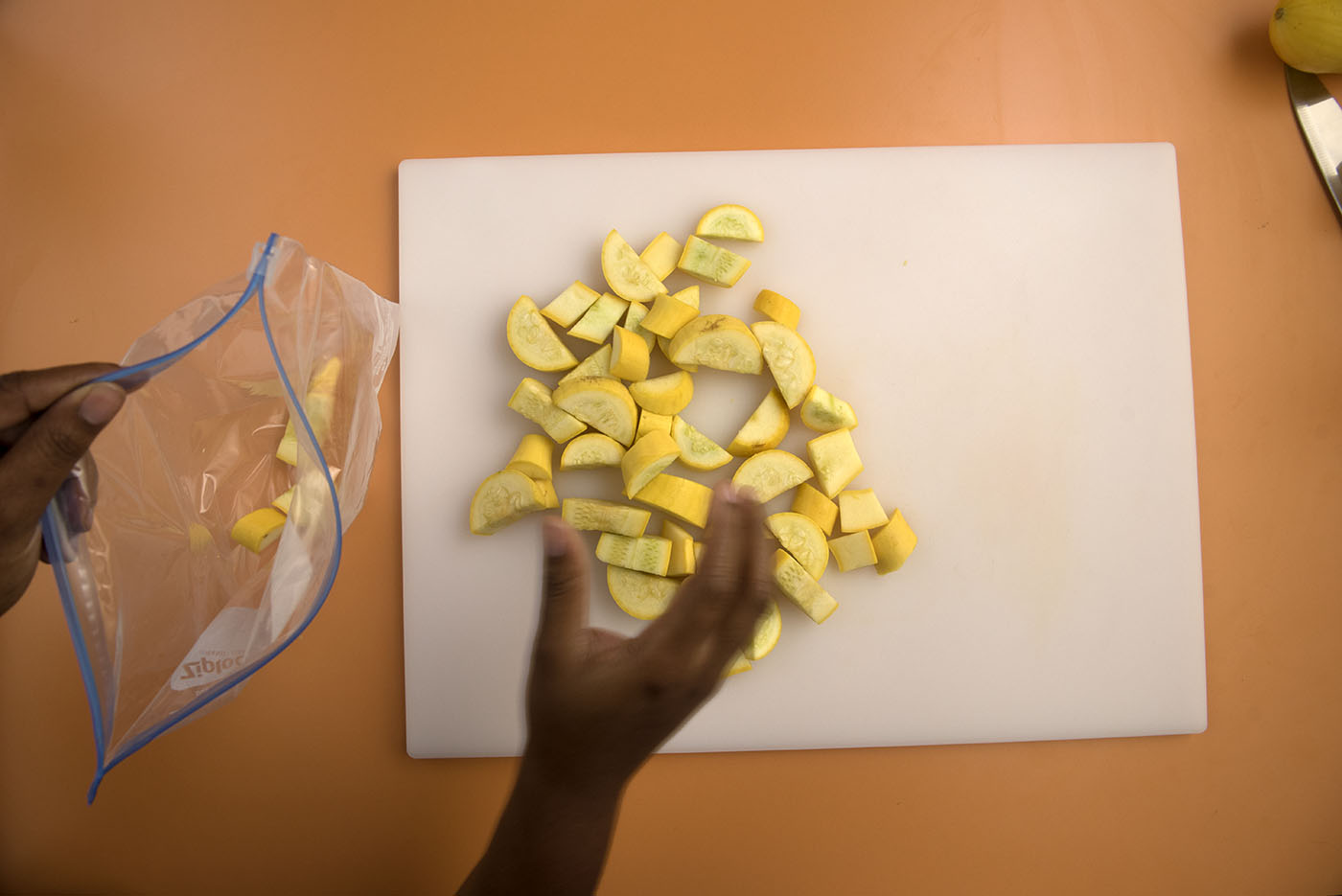
Thawing food safely
DO NOT thaw perishable foods at room temperature. Just ONE bacterium, doubling every 20 minutes, could grow to 64 bacteria in two hours, and 2,097,152 bacteria in seven hours!
If perishable foods, such as meat, are left at room temperature too long, bacteria may grow and produce heat-resistant toxins that can cause food-borne illness. Cooking may not be able to destroy these toxins.
- It’s best to plan ahead for slow, safe thawing in the refrigerator. Small items may thaw overnight in the refrigerator. Larger foods may take longer—allow approximately one day for each 5 pounds of weight.
- Thaw packages of raw meat, poultry, or seafood on plates on lower shelves of refrigerators to prevent their juices from dripping on other foods.
- For faster thawing, place food in a leak-proof plastic bag and immerse bag in COLD water. Change the water every 30 minutes to assure it stays cold. DO NOT use hot water. After thawing, refrigerate the food until ready to use. Food thaws in cold water at the rate of approximately a pound per half hour.
- If food is thawed in the microwave, cook it right away. Unlike food thawed in a refrigerator, microwave-thawed foods reach temperatures that encourage bacterial growth. Cook immediately to kill any bacteria that may have developed and to prevent further bacterial growth.
If thawing in a plastic freezer bag in the microwave, follow manufacturer’s directions for such things as venting, recommended heat settings, types of food suitable for microwave-thawing, etc. for that specific bag.
Follow microwave manufacturer’s directions for your specific microwave.
Washing Your Hands

Washing your hands
1. Wet your hands with warm (110°F), running water.

2. Apply soap.

3. Rub hands together for at least 20 seconds.

4. Clean under fingernails and between fingers.

5. Rinse hands thoroughly under running water.

6. Dry hands. Throw the towel in a trash can.
M1386 (POD-07-17) Distributed by Jenna Schilling, PhD, Extension Associate, Human Sciences.
Copyright 2017 by Mississippi State University. All rights reserved. This publication may be copied and distributed without alteration for nonprofit educational purposes provided that credit is given to the Mississippi State University Extension Service.
Produced by Agricultural Communications.
We are an equal opportunity employer, and all qualified applicants will receive consideration for employment without regard to race, color, religion, sex, national origin, disability status, protected veteran status, or any other characteristic protected by law.
Extension Service of Mississippi State University, cooperating with U.S. Department of Agriculture. Published in furtherance of Acts of Congress, May 8 and June 30, 1914. GARY B. JACKSON, Director
Freezing Vegetables
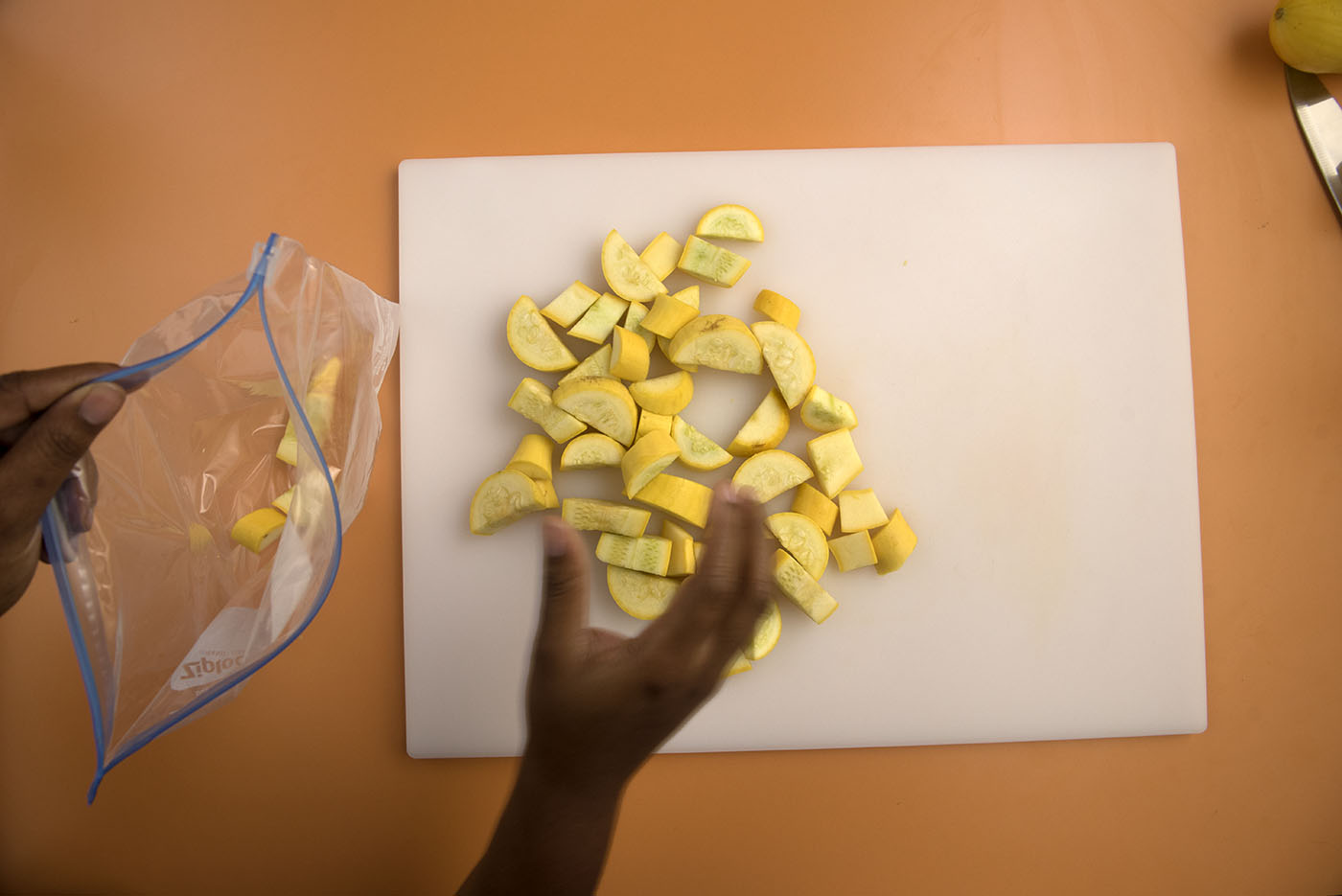
Freezing Vegetables
Freezing is a great way to keep fresh vegetables tasty and nutritious for a longer time than keeping them in the refrigerator or on the counter top.
Freezing doesn’t sterilize the vegetables, but the cold temperatures slow down the growth of bacteria. And the processes that cause vegetables to rot and spoil slow down, too.
Start with high-quality fresh vegetables. And freeze them soon after you get them.
Handle them carefully, to keep them from getting bruised or damaged before you freeze them.
Choose the Right Container
Choose containers that are intended to be used in the freezer. They should be moisture- and vapor-resistant. They should be durable and not become brittle in the freezer. And they should be easy to seal securely.
Good containers include plastic freezer containers, flexible freezer bags, or wide-mouth glass canning jars.
Don’t use the plastic containers that yogurt, tub margarine, or cottage cheese come in. And don’t use cardboard milk cartons or ice cream containers. And regular jars, like the ones jelly or mayonnaise come in, are made of thin glass that is likely to break when it is frozen.
Choose and Wash the Vegetables
Use the freshest, highest-quality vegetables you can find.
If you are picking them from your garden, pick them early in the morning, when it is still cool. Freeze them within a few hours after picking them.
Wash the vegetables well in cold water. Let the water run over them to wash away any dirt. If you are washing them in a sink or tub full of water, lift the vegetables out of the water and let the dirt settle to the bottom.
Sort the vegetables according to size. It will be easier to pack vegetables of similar size into the same container.
Blanch the Vegetables
Blanching means that you put the vegetables into boiling water for a short time before you put them in the freezer containers. For some vegetables, steaming is a better way to blanch.
Blanching is an important step for many reasons:
- It slows or stops the enzymes that cause food to rot or spoil.
- It cleans the surface of the vegetables, to remove any dirt or bacteria.
- It brightens the color.
- It helps keep the vitamins in the food.
- It softens or wilts the vegetables to make them easier to pack.
The amount of time you leave the vegetables in the boiling water is extremely important. The time varies according to the size of the vegetables and from one kind of vegetable to another.
Blanching for too short a time stimulates the enzymes that cause spoiling and is worse than not blanching at all.
Blanching for too long a time makes the vegetables lose flavor, color, and vitamins.
Safe Cooking Guidlines
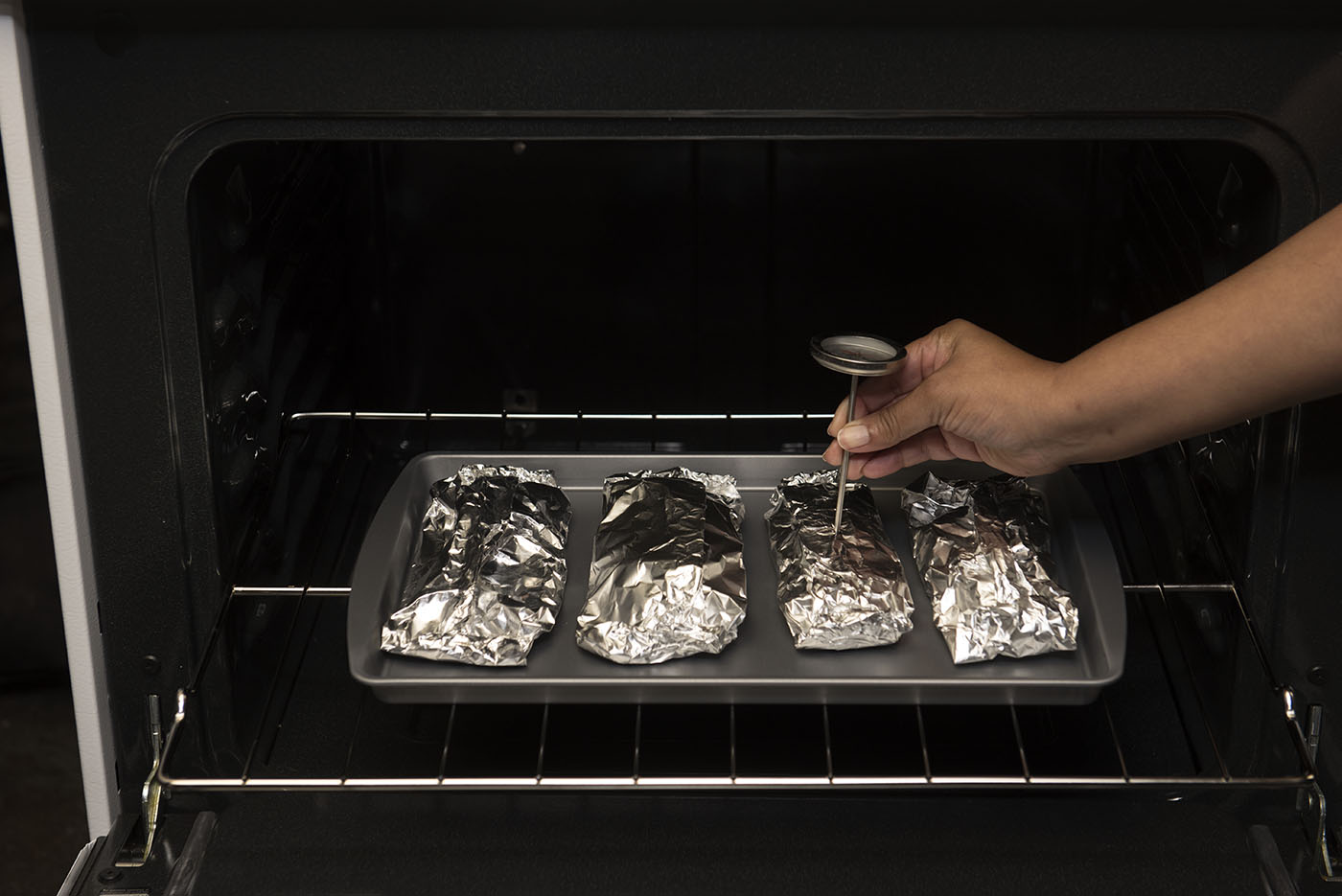
SAFE COOKING GUIDELINES
|
SAFE MINIMUM INTERNAL TEMPERATURES as measured with a food thermometer |
|
|
Beef, pork, veal, and lamb (roast, steaks, and chops) |
145°F with a three-minute “rest time” after removal from the heat source |
|
Ground meats |
160°F |
|
Poultry (whole, parts, or ground) |
165°F |
|
Eggs and egg dishes |
160°F, but cook eggs until both the yolk and the white are firm; scrambled eggs should not be runny |
|
Leftovers |
165°F |
|
Finfish |
145°F |
|
GUIDELINES FOR SEAFOOD |
|
|
Shrimp, lobster, crabs |
Flesh pearly and opaque |
|
Clams, oyster, and mussels |
Shells open during cooking |
|
Scallops |
Milky white, opaque and firm |
Partnership for Food Safety Education 2016
Food-borne Illness
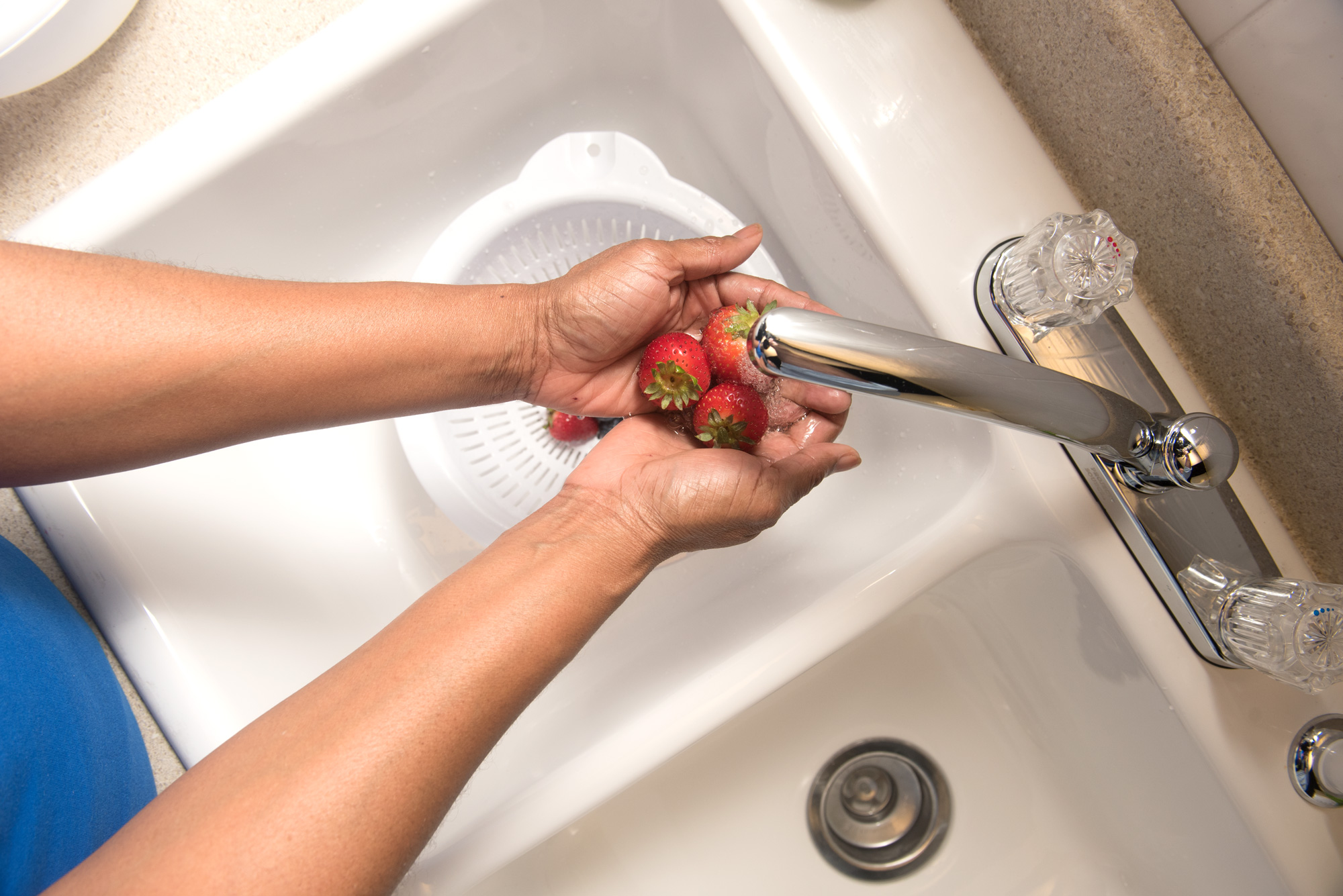
Keep safe from food-borne illness!
Follow these steps for keeping your food safe and your family healthy!
Check
- Check fruits and vegetables for mold, damage, cuts, and bruises.
- Check for expiration dates.
- Make sure that pre-cut fruit and salads are refrigerated.
- Check cans for dents, holes, and rusted seams.
- Make sure cans are not swollen.
Rinse
- Just before you use them, rinse fruits and vegetables.
- Scrub gently to remove any dirt you can see.
- Do not use soap or bleach.
Chill
- Keep your refrigerator at or below 40 degrees F.
- Refrigerate all cut, peeled, or cooked fresh fruits and vegetables within 2 hours.
Clean
- Wash your hands with soap and warm water for at least 20 seconds before and after you handle meat, fruits, and vegetables.
- Clean all counters, cutting boards, and knives in hot soapy water before and after using them.
Separate
- Keep raw meat, seafood, chicken, eggs, and household chemicals separate from fresh fruits and vegetables.
- Do not use the same cutting board or utensils for raw meat or chicken and for other foods. Use different ones, or wash them with hot soapy water before you use them for anything else.
Throw Away
- If foods that will be eaten uncooked have touched raw meat, poultry, seafood, or raw eggs, throw them away.
- Throw away any foods that are past their expiration dates.
- Throw away any foods that look moldy or spoiled. DO NOT TASTE them to see if they are still good.
Keeping Fresh Fruits & Vegetables Tasting Good
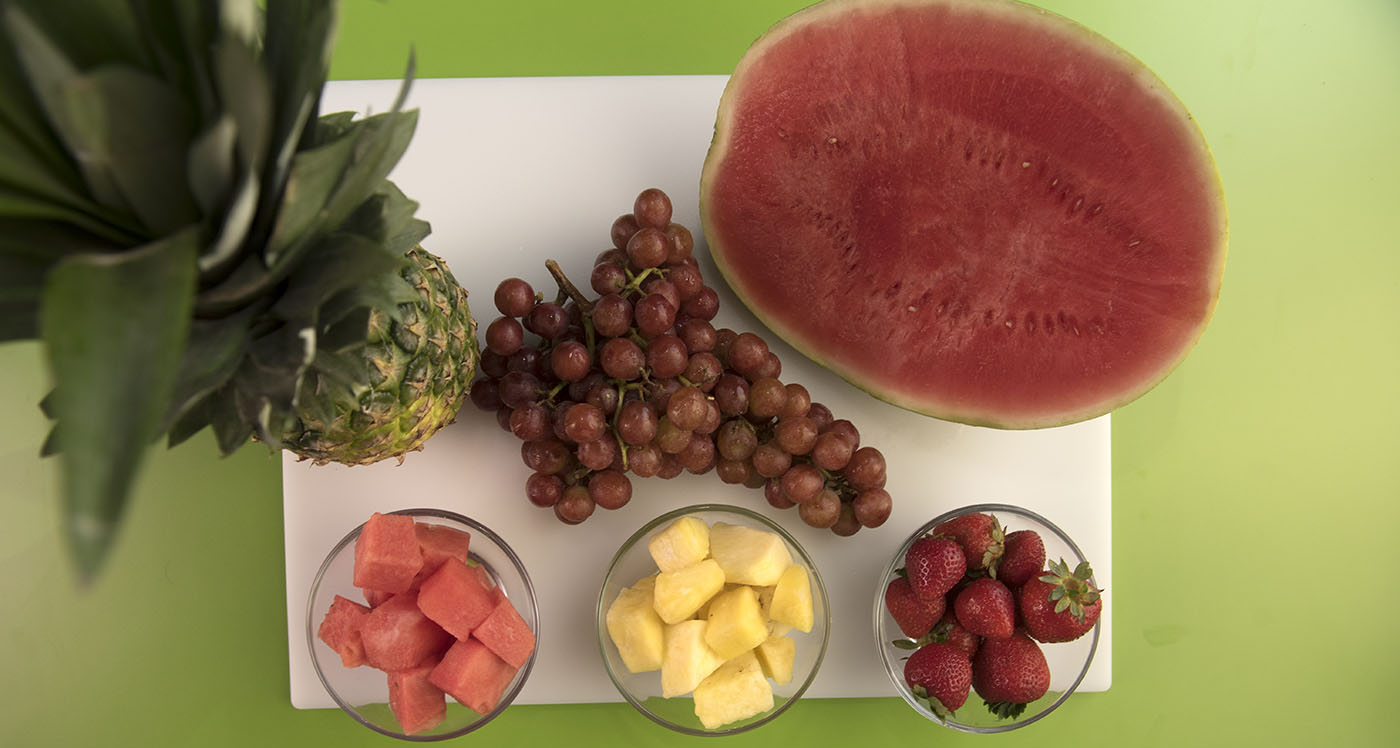
Keeping Fresh Fruits & Vegetables Tasting Good!
Keep these in the refrigerator
Fruits and Melons
- Apples (to keep for more than 7 days)
- Apricots
- Asian pears
- Blackberries
- Blueberries
- Cherries
- Cut fruit
- Figs
- Grapes
- Raspberries
- Strawberries
Vegetables
- Artichokes
- Asparagus
- Green beans
- Lima beans
- Beets
- Belgian endive
- Broccoli
- Brussels sprouts
- Cabbage
- Carrots
- Cauliflower
- Celery
- Cut vegetables
- Fresh herbs (but not basil)
- Green onions
- Greens (collard, mustard, turnip)
- Leeks
- Lettuce
- Mushrooms
- Peas
- Radishes
- Spinach
- Sprouts
- Summer squashes
- Sweet corn
Keep these on the counter until ripe, then keep them in the refrigerator
Fruits and Melons
- Avocados
- Kiwifruit
- Nectarines
- Peaches
- Pears
- Plums
- Plumcots
Keep these on the counter
Fruits and Melons
- Apples (to keep for less than 7 days)
- Bananas
- Grapefruit
- Lemons
- Limes
- Mandarins
- Mangoes
- Muskmelons
- Oranges
- Papayas
- Persimmons
- Pineapple
- Plantains
- Pomegranates
- Watermelons
Vegetables
- Basil (keep in a glass of water)
- Cucumbers
- Eggplant
- Ginger
- Jicama
- Peppers
- Pumpkins
- Tomatoes
- Winter squashes
Keep these in the pantry or a cabinet or box. Protect them from light, but make sure air can get to them
Vegetables
- Garlic
- Dry onions
- Potatoes
- Sweet potatoes
Expiration Dates

What do those dates mean on the food I buy?
Food dating stamps, like the Nutrition Facts label, give you good information about the food you buy. They can tell you when to keep a food and eat it, and when you should throw it out! You just need to know what the different stamps mean to keep your food safe to eat and tasting good, too.
Most of the dates you see on food are for quality, not food safety. Foods are often safe to eat past the date on the label, as long as there are no visible signs that the food is spoiled.
Use-By
This is last date recommended for use of the food. For the best taste and texture, use the food before the date has passed. It is not a safety date, except when used for baby formula.
Generally, throw away any food that is past the Use-By date. Some canned foods may still be good, but, when you open the can, if the color, texture, or odor of the food isn’t right, throw it out!
Exp
“Exp” stands for “Expiration” date. For the best taste and texture, use the food before the date has passed.
Generally, throw away any food that is past the Expiration date. The exception is eggs. If they have been kept in the refrigerator, eggs can still be used 3 to 5 weeks after the Expiration date.
Sell-By
This date tells the store how long to keep the food on the shelf for sale. It is not a safety date.
Use before or shortly after the date has passed. Sometimes, grocery stores will have sales on foods that are close to their Sell-By date. You can get a good bargain, but be sure to use it soon!
Do not buy foods that are past their Sell-By date.
Best if used by/before
For the best taste and texture, use before or shortly after the date has passed. This is not a purchase or safety date.
Throw away any foods that are more than a few days past the date. If the foods have not been stored properly, throw them out earlier.
Special Cases
For baby formula or pre-packaged, washed produce (like bags of salad), throw it away immediately when the date has passed. No exceptions!
For more information:
Food Safety and Inspection Service. USDA. Food Product Dating. https://www.fsis.usda.gov/wps/portal/fsis/topics/food-safety-education/get-answers/food-safety-fact-sheets/food-labeling/food-product-dating/food-product-dating
Food Safety for Pre-Schoolers
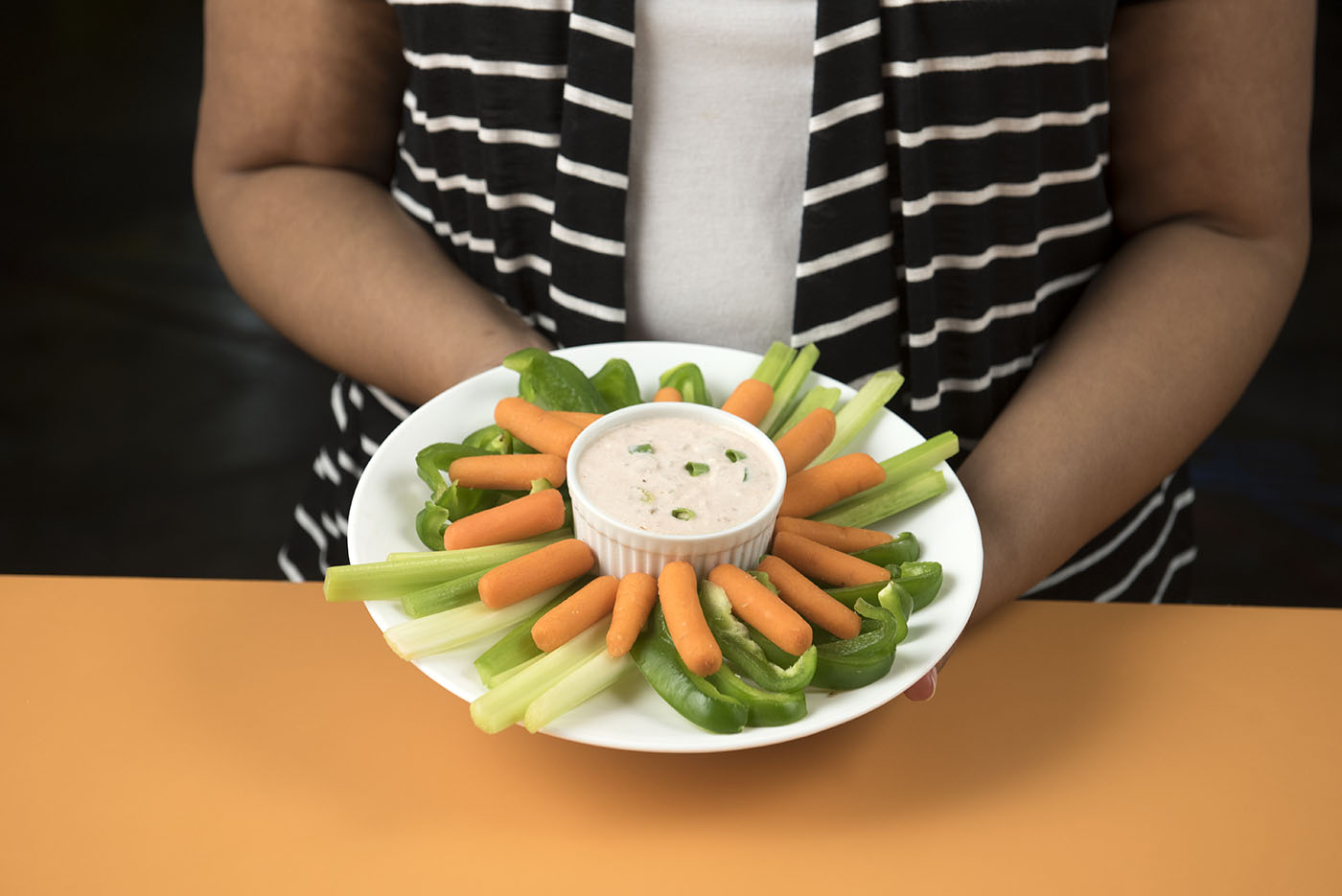
Food Safety for Pre-Schoolers
Keeping food safe for your children helps keep them healthy. Good habits about food safety will last a lifetime!
Wash hands
Teach your children to wash their hands before and after eating, after using the bathroom, after playing with pets, and whenever their hands are dirty.
Keep a stool by the sink to help small children reach it more easily.
Sing the Alphabet Song or “Happy Birthday to You” or “Twinkle, Twinkle, Little Star” while hand washing. This will help you make sure that the children wash their hands for at least 20 seconds each time.
Let your children pick out a favorite soap that they will have fun using.
Children who wash their hands often are less likely to get sick.
Keep things clean
Small children get sick more easily because their immune systems are not fully developed. Keep food and the counter tops and table tops clean.
Wash surfaces and utensils before and after you prepare meals or snacks for your children.
Prevent choking
Don’t choose foods that are hard to swallow. Or cut them into pieces 1/2 inch or smaller. These foods include peanuts, popcorn, hot dog slices, hard candy, whole grapes, and cherry tomatoes.
Make sure your children sit down when they are eating. Don’t let them run, walk, play, or lie down while they have food in their mouths.
Pack a safe, healthy lunch
Keep cold foods cold by adding a frozen juice box, water bottle, or small ice pack to an insulated lunch bag. If you are using paper lunch sacks, double them up to help keep things cold. By lunch time, the juice box or water bottle will have thawed enough to drink!
Keep hot foods hot in an insulated thermos. Be sure to prime the thermos first, by filling it with boiling water. Let it stand for a few minutes, then pour the water out. Fill the thermos with piping hot soup or stew!
Keep snacks safe
If snacks come in a large box or bag, divide them up right away into small, single-serving bags. Many hands digging into the big box can spread germs to all the snacks inside.
Rinse fruits and vegetables before slicing them to serve as snacks.
Hard-cooked eggs
Hard-cooked eggs can be an easy and nutritious food for small children.
Before cooking, always keep the eggs in the refrigerator. After cooking, return them to the refrigerator within 2 hours.
If you are dyeing the eggs for the holidays, be sure to use food-safe coloring.
Choose healthy fish
The fats in fish and shellfish are good for young children, and adults, too! But some fish can also contain high levels of mercury and other toxic chemicals. Fish that are usually lower in mercury are catfish, pollock, salmon, sardines, tilapia, and trout
Food Safety at Barbecues

Food Safety at Barbecues and Picnics
Outdoor barbecues and picnics are a great way to connect with family and friends. However, careless food handling could cause foodborne illness and quickly make you an unpopular host. Taking just a few simple steps can greatly reduce the risk of sickness. These tips will help ensure that your food stays safe and your guests stay healthy.
Stay Out of the Danger Zone!
Just like humans, bacteria thrive in temperatures that are not too hot or too cold. The “danger zone” is 40 to 140 degrees Fahrenheit. Dangerous bacteria are more likely to grow in this temperature range. Keep cold foods below 40° F and hot foods above 140° F.
Thaw Appropriately
Frozen meat should never be thawed at room temperature. Instead, thaw in the refrigerator ahead of time. If it’s last minute, submerge sealed packages in cold (not warm or hot) water, or thaw in the microwave. Thoroughly cook foods immediately after microwave thawing.
Marinate Well
Marinating meat can improve tenderness, juiciness, and flavor. Always marinate food in the refrigerator, not on the countertop. If you plan to use the marinade as a baste during grilling, reserve some for basting before you put the raw meat in it. Discard marinade as soon as you take the meat out of it.
Precook Wisely
Precooked meats such as hot dogs, smoked sausages, chicken breasts, or burgers are great options that are available at many retail stores. Simply follow the package instructions for reheating on the grill. If you precook foods yourself, make sure they go immediately on the grill; don’t hold them at room temperature before putting on the grill.
Use Coolers Properly
When picnicking or tailgating away from home, use a cooler to store anything that was refrigerated. Fill it just before leaving home, add plenty of ice, and don’t open the cooler repeatedly; it makes the ice melt faster. Consider having a separate tub or cooler for drinks to avoid repeatedly opening the cooler with perishable foods. Always separate raw meat from ready-to-eat foods like salads and desserts. Try to keep the cooler in a shaded area to maintain temperature more efficiently.
Cook to Temp
Digital food thermometers can be purchased for around $10, and they’re easy to use and read. Consider them an easy and inexpensive way to both prevent foodborne illness and make sure you don’t overcook your steaks. The thermometer should be placed in the center of the food, not touching bones or big pieces of fat or gristle. Use the cooking temperatures chart to determine when different meat products are safe.
Serve Safely
Keep cold foods cold by placing the bowl of food inside of a slightly larger bowl filled with ice. Keep hot foods hot on the grill (not directly over the coals) and with crock pots, chafing dishes, or “beer baths.” To make a beer bath, fill a pan with beer, juice, broth, or other liquid, and place it on the grill; after cooking burgers, chicken, or brats, place them in the hot liquid to keep the food hot and add extra flavor.
A general rule of thumb is never to leave perishable items out of the refrigerator for more than 2 hours, or for more than 1 hour when the outside temperature is above 90°F. Here in Mississippi, the summer temperature can soar above 90°F for weeks on end. It’s important to make sure food is not left out more than an hour on these hot days. The food will not only be safer, but it will also look better and taste fresher. In hotter months, consider holding your gathering in the evening hours, when temperatures cool off and your guests may be more comfortable. Also consider adding nonperishable items to your picnic. Whole fruits like grapes, apples, bananas, oranges, peaches, and cherry tomatoes, along with crackers, pretzels, nuts, chips, breads, and cookies can be added to the menu and don’t have to take up valuable cooler space. However, cut or pre-peeled fruits and vegetables should always be kept cool, and you should follow the same handling guidelines for other refrigerated items.
Handle Leftovers Correctly
Put food in the refrigerator, freezer, or cooler within 2 hours if the temperature outside is less than 90°F, or within 1 hour if the temperature is above 90°F. If foods stay out for too long, or if you are unsure whether or not they are safe, discard them. Reheat leftovers to 165°F.
Clean Thoroughly
Never put cooked meat or other foods on the same plate that held raw meat. That raw meat juice contains bacteria that will recontaminate your food. Don’t want to wash double dishes? Use disposables for raw and cooked foods. Always wash your hands after handling raw meat and before you touch cooked meat.
If you are away from home, make sure you have a potable water source for cleanup, or bring containers from home if necessary. Supplement water with antibacterial wipes for cleaning tables and other surfaces, and consider using disposable containers and utensils, especially for raw items.
Safe Internal Temperatures for Meat and Poultry Products
Product Safe internal temperature (degrees Fahrenheit)
- Poultry (chicken or turkey): whole birds, breast meat, legs, thighs, wings: 165°
- Ground poultry (chicken/turkey): 165°
- Fish: 145°
- Pork chops, roasts, ribs: 145° plus 3 minutes standing time
- Lamb chops, roasts: 145° plus 3 minutes standing time
- Beef steaks, roasts: 145° plus 3 minutes standing time
- Ground beef, pork, lamb: 160°
Source: www.fsis.usda.gov
Publication 3046 (POD-05-17)
By Christine Leick Cord, PhD, Postdoctoral Associate, Food Science, Nutrition, and Health Promotion. Adapted from Food Safety and Inspection Service, United States Department of Agriculture. Safe Food Handling. Available Here.
Accessed May 2, 2017.
Copyright 2017 by Mississippi State University. All rights reserved. This publication may be copied and distributed without alteration for nonprofit educational purposes provided that credit is given to the Mississippi State University Extension Service.
Produced by Agricultural Communications. We are an equal opportunity employer, and all qualified applicants will receive consideration for employment without regard to race, color, religion, sex, national origin, disability status, protected veteran status, or any other characteristic protected by law.
Extension Service of Mississippi State University, cooperating with U.S. Department of Agriculture. Published in furtherance of Acts of Congress, May 8 and June 30, 1914. GARY B. JACKSON, Director